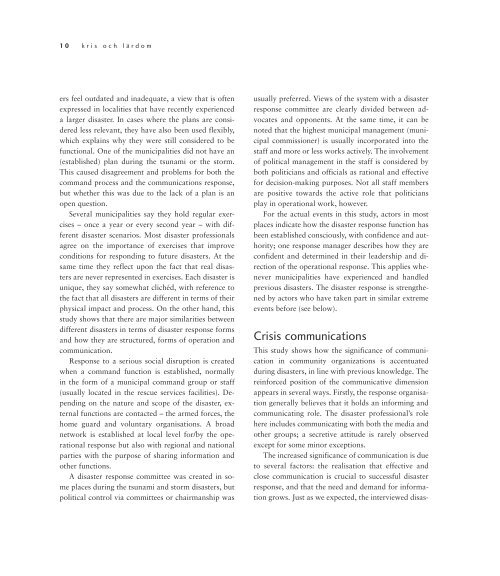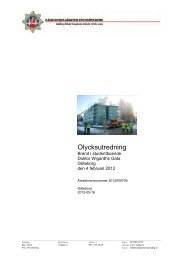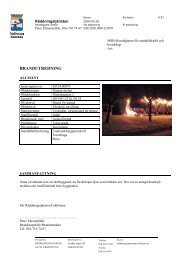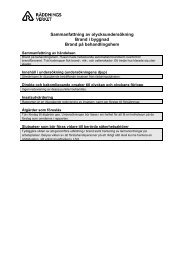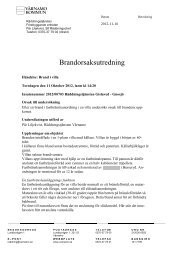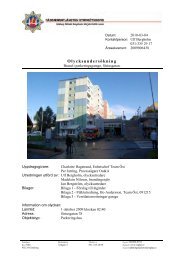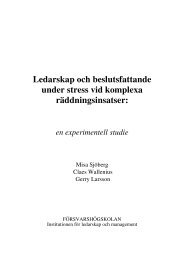Sverige
Sverige
Sverige
You also want an ePaper? Increase the reach of your titles
YUMPU automatically turns print PDFs into web optimized ePapers that Google loves.
10 kris och lärdom<br />
ers feel outdated and inadequate, a view that is often<br />
expressed in localities that have recently experienced<br />
a larger disaster. In cases where the plans are considered<br />
less relevant, they have also been used flexibly,<br />
which explains why they were still considered to be<br />
functional. One of the municipalities did not have an<br />
(established) plan during the tsunami or the storm.<br />
This caused disagreement and problems for both the<br />
command process and the communications response,<br />
but whether this was due to the lack of a plan is an<br />
open question.<br />
Several municipalities say they hold regular exercises<br />
– once a year or every second year – with different<br />
disaster scenarios. Most disaster professionals<br />
agree on the importance of exercises that improve<br />
conditions for responding to future disasters. At the<br />
same time they reflect upon the fact that real disasters<br />
are never represented in exercises. Each disaster is<br />
unique, they say somewhat clichéd, with reference to<br />
the fact that all disasters are different in terms of their<br />
physical impact and process. On the other hand, this<br />
study shows that there are major similarities between<br />
different disasters in terms of disaster response forms<br />
and how they are structured, forms of operation and<br />
communication.<br />
Response to a serious social disruption is created<br />
when a command function is established, normally<br />
in the form of a municipal command group or staff<br />
(usually located in the rescue services facilities). Depending<br />
on the nature and scope of the disaster, external<br />
functions are contacted – the armed forces, the<br />
home guard and voluntary organisations. A broad<br />
network is established at local level for/by the operational<br />
response but also with regional and national<br />
parties with the purpose of sharing information and<br />
other functions.<br />
A disaster response committee was created in some<br />
places during the tsunami and storm disasters, but<br />
political control via committees or chairmanship was<br />
usually preferred. Views of the system with a disaster<br />
response committee are clearly divided between advocates<br />
and opponents. At the same time, it can be<br />
noted that the highest municipal management (municipal<br />
commissioner) is usually incorporated into the<br />
staff and more or less works actively. The involvement<br />
of political management in the staff is considered by<br />
both politicians and officials as rational and effective<br />
for decision-making purposes. Not all staff members<br />
are positive towards the active role that politicians<br />
play in operational work, however.<br />
For the actual events in this study, actors in most<br />
places indicate how the disaster response function has<br />
been established consciously, with confidence and authority;<br />
one response manager describes how they are<br />
confident and determined in their leadership and direction<br />
of the operational response. This applies whenever<br />
municipalities have experienced and handled<br />
previous disasters. The disaster response is strengthened<br />
by actors who have taken part in similar extreme<br />
events before (see below).<br />
Crisis communications<br />
This study shows how the significance of communication<br />
in community organizations is accentuated<br />
during disasters, in line with previous knowledge. The<br />
reinforced position of the communicative dimension<br />
appears in several ways. Firstly, the response organisation<br />
generally believes that it holds an informing and<br />
communicating role. The disaster professional’s role<br />
here includes communicating with both the media and<br />
other groups; a secretive attitude is rarely observed<br />
except for some minor exceptions.<br />
The increased significance of communication is due<br />
to several factors: the realisation that effective and<br />
close communication is crucial to successful disaster<br />
response, and that the need and demand for information<br />
grows. Just as we expected, the interviewed disas-


